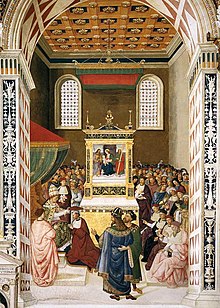Noon bells
The ringing of noon , also ringing of twelve or (midday) Angelus is in churches the ringing of church bells at noon .
description
When peal of church bells two forms can be distinguished.
- Church ( sacred ) ringing (call to worship , to prayer, to change , on the death of the bishop or pope , after the ordination of a bishop , when visiting a particularly high-ranking person)
- Secular ( secular , also: profane) ringing (hour display, conflagration, storm, alarm)
The noon ringing is thus both a sacred and profane ringing.
purpose
- From a church perspective, the midday bell rings for the Passion of Christ on the Cross ( sixth ) and calls for prayer and vigilance. In the Roman Catholic Church the angel of the Lord has been prayed at noon since the end of the Middle Ages .
- From a mundane point of view, the noon bell has (had) the function of publicly announcing an important point in the daily routine. The sound of the church bells still interrupts work in the field or in the workshop for lunch.
origin

The custom of ringing church bells at noon can be traced back to the time when the armies of Turks threatened the Christian West. Pope Calixt III. (1378-1458) of the House of Borgia arranged on June 29, 1456 in a bull that one or more bells should noon to call by their ringing the faithful for a victory of the Hungarians under their leader John Hunyadi over the Turks to pray. While the bells were ringing, Christians were to pray three Our Fathers and three Hail Marys.
The army of Sultan Mehmed II was defeated on July 22nd, 1456 near the castle Nándorfehérvár (today Belgrade ) despite its overwhelming superiority by an alliance of Hungarian troops and a peasant crusader army. Pope Kalixt III. did not receive the news of victory until August 6, 1456. Due to the temporal proximity of the events and the long communication channels at that time, the clergy and the faithful assumed that from now on the church bells would ring out of joy at the defeat of the Muslims. After the threat of the Ottoman Empire against Europe was not averted for centuries despite this victory, the papal order was continued and maintained as a custom to this day. It entered common usage as the Turkish bell .
The morning, noon and evening angelus chimes are a reminder of the Incarnation of Christ and call the faithful to the prayer of the Angel of the Lord .
Curiosities

- At burials, the church bells usually ring 30 minutes after the funeral begins. However, if a funeral takes place at 11:30 a.m., the bell must be rung immediately at the beginning of the funeral ceremony, as otherwise the time of the noon bells would overlap.
- The Bavarian saying goes from ancient times that white sausages should not be allowed to hear the noon ringing. In other words: In addition to crispy pretzels and a wheat beer, freshly scalded veal sausages are the ideal component of a second breakfast, which should be taken between 10 a.m. and 11 a.m. Of course, this rule no longer needs to be adhered to in times of appropriate cooling and other preservation techniques. In addition, white sausages are no longer “raw”, but i. A. pre-brewed in the sales counters. Nevertheless, this wisdom is still seen in many companies and offices as legitimation for a "resting phase".
- In most of the villages in the Hessian Ried, the church bells ring at 11 a.m. In the past, people ate lunch there at eleven o'clock.
Web links
literature
- Handbook of Church History, p. 6442, Kalixt III. (1455-1458), III. The Medieval Church: Part Two: The Late Middle Ages. Handbook of Church History, p. 6442
